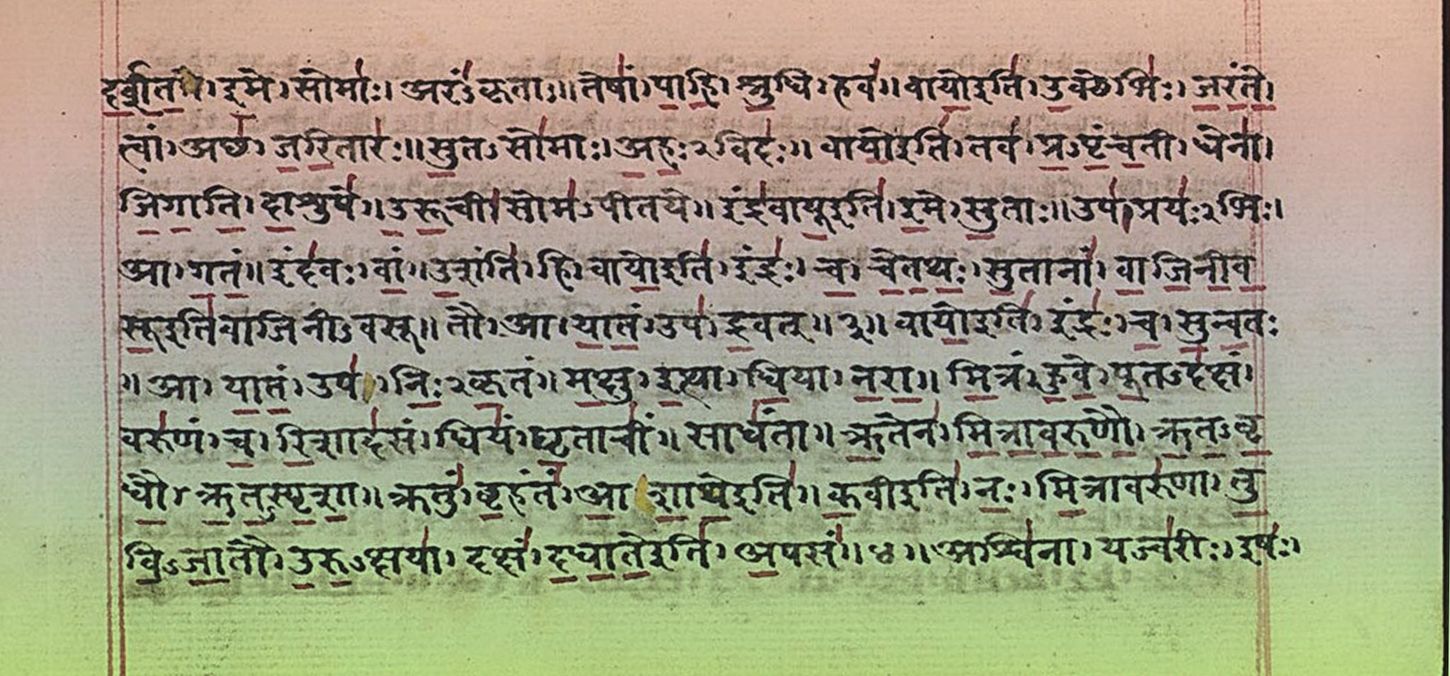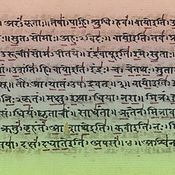
Alles kann für Dich zu einem Objekt (deśa) Deiner Meditation werden. Treffe die bewusste Entscheidung Dich darauf zu Fokussieren (bandha). Diese Konzentration (dhāraṇā) ist der Einstieg für Deine Meditation.
Dr. Ronald Steiner - moderner Transfer
Das Binden (bandhaḥ | nom sg) des Wahrnehmungsraumes (cittasya | gen sg) an einen Ort [am Körper] (deśa | tp loc), [das ist die] Konzentration (dhāraṇā | nom sg).
Dr. Ronald Steiner - historisch-wörtlich
Vyāsa Bhāṣya zu 3.1.
nābhicakre hṛdayapuṇḍarīke mūrdhni jyotiṣi nāsikāgre jihvāgra ity evamādiṣu deśeṣu bāhye vā viṣaye cittasya vṛttimātreṇa bandha iti dhāraṇā. 3.1
Binding of the mind-stuff, only in so far as it is a fluctuation, to the navel or to the heart-lotus or to the light within the head or to the tip of the nose or to the tip of the tongue or to other 1 places of the same kind or to an external object, this is fixed-attention.
James Haughton Woods - 1914
| 1: | Compare Maitrī Upan. vi. 20 and Garuḍa Pur. ccxxvi.21. |
Das Binden (bandhaḥ | nom sg) des Geistes (cittasya | gen sg), nur durch seine Funktion (vṛttimātreṇa | ins sg), auf den Nabelkreis (nābhicakre | loc sg), auf den Herz-Lotus (hṛdaya-puṇḍarīke | loc sg), auf das Licht (jyotiṣi | loc sg) im Kopf (mūrdhni | loc sg), auf die Nasenspitze (nāsikāgre | loc sg) oder auf die Zungenspitze (jihvāgre | loc sg) oder auf Orte (deśeṣu | loc pl) von der eben erwähnten Art (evamādiṣu | loc pl) oder (vā) auf ein äußeres (bāhye | loc sg) Objekt (viṣaye | loc sg), das ist (iti) Konzentration (dhāraṇā | nom sg).
Erläuterung zum Vyāsa Bhāṣya
Es ist spannend, dass der Bhāṣya anscheinend nicht beliebige Meditationsobjekte im Sinn hat, sondern vorschlägt spezifisch den Geist an bestimmte Orte am Körper zu lenken.
Binding the mind-stuff to a place is fixed-attention.
James Haughton Woods - 1914
Die Bindung des Cittam an einen Ort ist die Fesselung.
Paul Deussen - 1908
Fixing the internal organ (Citta) on a place is dhāraṇā (attention).
James R. Ballantyne - 1852
Ganz natürlich entsteht aus Konzentration (dhāraṇā) die Versenkung (dhyāna). Diese stellt sich ein, wenn Deine gesamte Wahrnehmung (pratyaya) von eingenommen wird von nur dem einen Objekt (ekatānatā) Deiner Versenkung.
Dr. Ronald Steiner - moderner Transfer
[Ist] dort (tatra) [in der Konzentration (dhārana) der innere Wahrnehmungsraum (citta)] auf nur einen Bewusstseinsinhalt gerichtet (pratyaya-ekatānatā | nom sg) [gerichtet], [ist das die] Versenkung (dhyānam | nom sg).
Dr. Ronald Steiner - historisch-wörtlich
Vyāsa Bhāṣya zu 3.2
tasmin deśe dhyeyālambanasya pratyayasyaikatānatā sadṛśaḥ pravāhaḥ pratyayāntareṇāparāmṛṣṭo dhyānam. 3.2
The focusedness of the presented idea upon the object to be contemplated 1 in that place, in other words, the stream [of presented ideas] of like quality unaffected by any other presented idea.
James Haughton Woods - 1914
| 1: | See Garuḍa Pur. ccxxxv. 28. 29. |
Versenkung (dhyānam | nom sg) ist die Fokussierung (ekatānatā | nom sg) der Vorstellung (pratyayasya | gen sg) des Meditationsobjektes (dhyeya-ālambanasya | gen sg) auf diesen (tasmin | loc sg) Ort (deśe | loc sg), d.h. ein gleichförmiger (sadṛśaḥ | nom sg) Strom (pravāhaḥ | nom sg), unberührt (aparāmṛṣṭaḥ | nom sg) durch andere Vorstellungen (pratyaya-antareṇa | ins sg).
Focusedness of the presented idea upon that place is contemplation.
James Haughton Woods - 1914
Dabei erfolgt als Richtung des Vorstellungsvermögens auf einen Punkt die Meditation.
Paul Deussen - 1908
A course of uniform (fixed on only object) modification of knowledge at that place (Where the internal organ is fixed in Dhāraṇā) is dhyāna (contemplation).
James R. Ballantyne - 1852
Schließlich tauchst Du so tief in Deine Versenkung (dhyāna) ein, dass Du Dich selbst darin komplett vergisst (svarūpa-śūnyam). Dann besteht für Dich nur noch Dein Meditationsobjekt (artha-mātra-nirbhāsa). Du bist dann in einem Auflösungs-Zustand (samādhi). Du löst Dich von Deinem individuellen Selbst und erfährst Einheit mit Deinem Wesenskern (puruṣa).
Dr. Ronald Steiner - moderner Transfer
Genau (eva) diese (tad | nom sg) [Versenkung (dhyāna)], die den Schein von nur einem Objekt (artha-mātra-nirbhāsam | nom sg) [hat], als ob (iva) Leere der eigenen Form (svarūpa-śūnyam | nom sg) [besteht], [ist] der Auflösungs-Zustand (samādhiḥ | nom sg).
Dr. Ronald Steiner - historisch-wörtlich
Vyāsa Bhāṣya zu 3.3.
dhyānam eva dhyeyākārānirbhāsaṃ pratyayātmakena svarūpeṇa śūnyam iva yadā bhavati dhyeyasvabhāvāveśāt tadā samādhir ity ucyate. 3.3
When the contemplation only shines forth [in consciousness] in the form of the object-to-be-contemplated and [so] is, as it were, empty of itself, in so far as it becomes identical with the presented-idea as such, then, by fusing [itself] with the nature of the object-to-be-contemplated, it is said to be concentration.
James Haughton Woods - 1914
Genau diese (eva) Versenkung (dhyānam | nom sg), die Erscheinung (nirbhāsam | nom sg) der Form (ākārā) des Meditationsobjektes (dhyeya) habend, wenn (yadā | adv) es so ist (bhavati | 3p sg pres), wie (iva) frei (śūnyam) von seiner eigenen Natur (svarūpeṇa | ins sg), [nur] bestehend aus der Vorstellung (pratyaya-ātmakena | ins sg) durch das Eintreten (āveśāt | abl sg) in das Wesen des Meditationsobjektes (dhyeya-svabhāva), dann (tadā | adv) wird das (iti) Auflösung (samādhiḥ | nom sg) genannt (ucyate | 3p sg pres pass).
This same [contemplation], shining forth [in consciousness] as the intended object and nothing more, and, as it were, emptied of itself, is concentration.
James Haughton Woods - 1914
Diese, wenn sie nur das Objekt widerspiegelt und gleichsam der eigenen Natur ledig ist, heißt Versenkung (vgl. 1,43).
Paul Deussen - 1908
The same (contemplation) when it arises only about a material substance or object of sense (and therefore) is (then) like a non-existence of itself (that is like ignorance is samādhi (meditation).
James R. Ballantyne - 1852
Du tauchst ganz natürlich immer tiefer in Deine Meditation (saṁyama) ein. Dabei beginnst Du mit Konzentration (dhāraṇā). Diese mündet in Versenkung (dhyāna). Schließlich entsteht die Wesenskern-Erfahrung (samādhi).
Dr. Ronald Steiner - moderner Transfer
Die drei (trayam | nom sg) [Konzentration (dhāraṇā), Versenkung (dhyāna), Auflösungs-Zustand (samādhi) bilden] zusammengenommen (ekatra) die Meditation (saṁyamaḥ | nom sg).
Dr. Ronald Steiner - historisch-wörtlich
Vyāsa Bhāṣya 3.4
tad etad dhāraṇādhyānasamādhitrayam ekatra saṃyamaḥ.
These same three, fixed-attention and contemplation and concentration, in one are constraint.
James Haughton Woods - 1914
Genau diese (tad etad) Dreiheit aus Konzentration, Versenkung und Auflösung (dhāraṇā-dhyāna-samādhi-trayam | nom sg) auf einen Ort (ekatra | loc sg) gerichtet, ist Meditation (saṃyamaḥ | nom sg).
ekaviṣayāṇi trīṇi sādhanāni saṃyama ity ucyate.
When having a single object the three means are called constraint.
James Haughton Woods - 1914
Die drei (trīṇi | nom pl) Werkzeuge (sādhanāni | nom pl) auf ein Objekt (eka-viṣayāṇi | loc sg) gerichtet, das (iti) wird Meditation (saṃyamaḥ | nom sg) genannt (ucyate | 3p sg pres pass).
tad asya trayasya tāntrikī paribhāṣā saṃyama iti. 3.4
So the technical term [now laid down] in this system for these three is constraint.
James Haughton Woods - 1914
Und der (tad | nom sg) technische Begriff (paribhāṣā | nom sg), der in diesem Lehrbuch (tāntrikī | loc sg) gelehrt wird, für diese (asya | gen sg) Dreiheit (trayasya | gen sg) ist Meditation (saṃyamaḥ | nom sg).
Erläuterung zum Vyāsa Bhāṣya
Der Bhāṣya zu 3.4 sagt demnach sinngemäß aus, dass Saṃyama der technische Begriff in diesem Lehrbuch für Dharaṇā, Dhyāna, Samādhi ist, wenn alle drei auf ein Objekt gerichtet sind.
The three in one are constraint.
James Haughton Woods - 1914
[Die Fassung] der drei [Fesselung, Meditation und Versenkung] in eines ist die Allzucht.
Paul Deussen - 1908
These there (when they operate only) on one object, constitute sanyama.
James R. Ballantyne - 1852



 Dr. Ronald Steiner
Dr. Ronald Steiner
 Laura von Ostrowski
Laura von Ostrowski

Nachrichten und Bewertungen